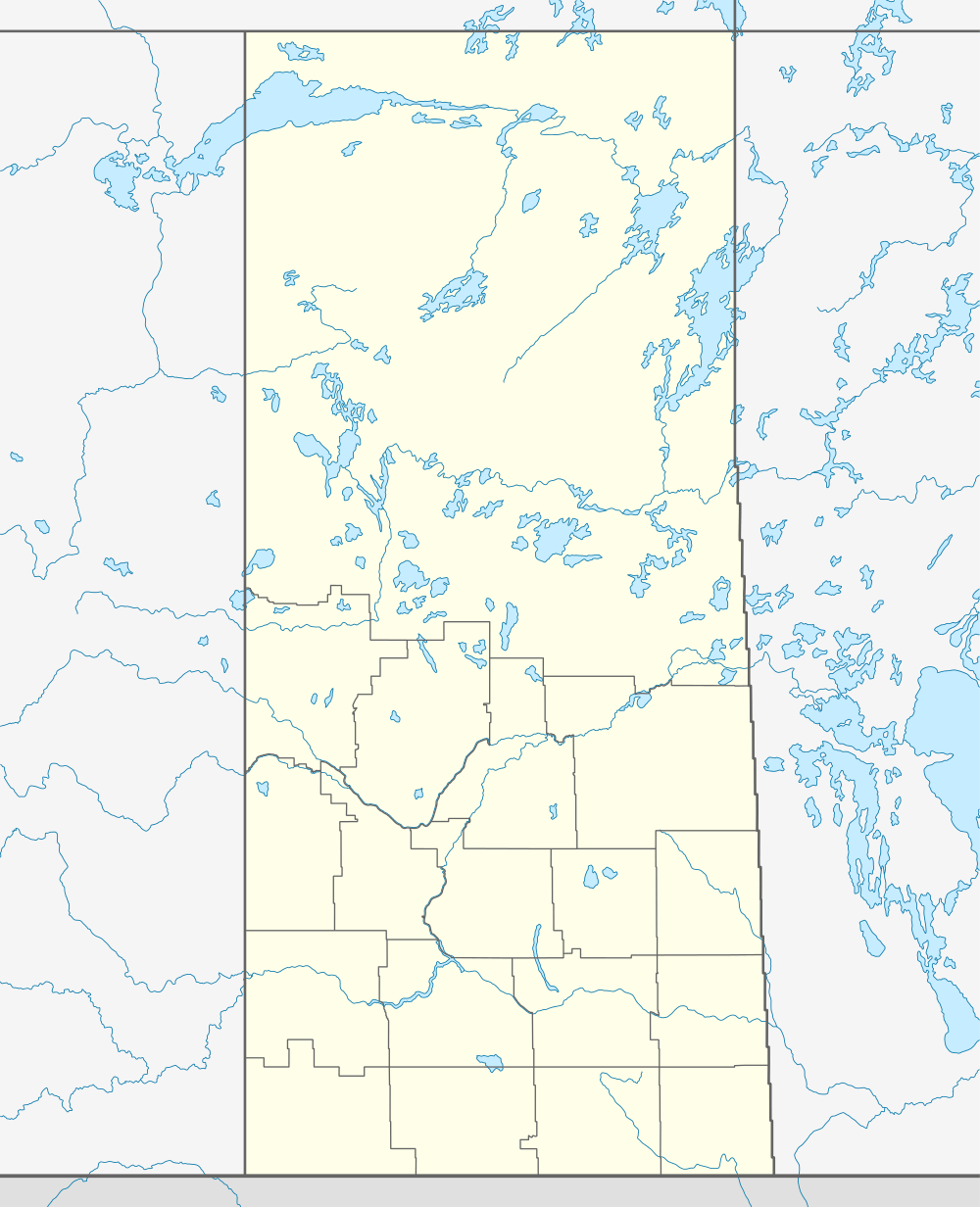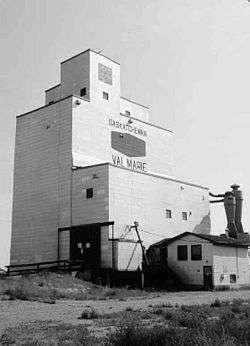Val Marie, Saskatchewan
| Village of Val Marie | |
|---|---|
| Village | |
|
Val Marie grain elevator | |
 Village of Val Marie  Village of Val Marie Location of Val Marie | |
| Coordinates: 49°13′59″N 107°44′05″W / 49.233°N 107.7346°WCoordinates: 49°13′59″N 107°44′05″W / 49.233°N 107.7346°W | |
| Country | Canada |
| Province | Saskatchewan |
| Region | Saskatchewan |
| Rural Municipality | Val Marie No. 17 R. M. |
| Elevation | 795 m (2,608 ft) |
| Population (2006) | |
| • Total | 137 |
| Time zone | CST |
| Postal code | S0N 2T0 |
| Area code(s) | 306 |
| Climate | BSk |
Val Marie is a prairie village located in the southwestern region of Saskatchewan, Canada. It is only a few kilometres from the Canada-United States border.
Considered the gateway to the Grasslands National Park, Val Marie's economy is largely based on wheat farming, ranching, and tourism. Minor amounts of natural gas have been found nearby. Employment includes agriculture (47% of workforce), federal government (Grasslands National Park), and a significant natural gas compressor relay station at the Montana border.
Demographics
| Canada census – Val Marie, Saskatchewan community profile | |||
|---|---|---|---|
| 2011 | 2006 | ||
| Population: | 98 (-28.5% from 2006) | 137 (2.2% from 2001) | |
| Land area: | 0.42 km2 (0.16 sq mi) | 0.42 km2 (0.16 sq mi) | |
| Population density: | 233.6/km2 (605/sq mi) | 326.5/km2 (846/sq mi) | |
| Median age: | 49.5 (M: 49.5, F: 49.5) | 43.5 (M: 40.5, F: 43.8) | |
| Total private dwellings: | 62 | 79 | |
| Median household income: | $50,000 | ||
| References: 2011[1] 2006[2] | |||
History

The first European investigation of the area was conducted by the Palliser Expedition (1857–1859), supported by the Royal Geographical Society and the British Government, and led by John Palliser, a wealthy Irish landowner. He was accompanied by geologist James Hector, and various cartographers and botanists. They studied the natural resources and agricultural potential of the Palliser area – including Val Marie – and reported the place as dismally dry, prone to drought, and unfit for habitation. The dismissive conclusions slowed settlement in the area for decades.
Artifacts of native civilization are significant. In 1877, Tatanka Iyotake – Sitting Bull – crossed from the USA into Canada along the Frenchman River (which flows through Val Marie) after his victory over General Custer at Battle of the Little Bighorn.
The village of Val Marie – Valley of Mary – was founded in 1910 by Father Passaplan, Louis Denniel, and the brothers François and Léon Pinel. Most of the early settlers were ranchers and farmers from Quebec and France. By 1939, two irrigation reservoirs were built near Val Marie by the PFRA (Prairie Farm Rehabilitation Agency) in coordination with Ducks Unlimited. Over 10,000 acres (40 km2) are irrigated through the system which provides some stabilization through droughts which plague the area.
Originally settled by French ranchers, the village remained largely ethnically French and by the 1950s had 450 people. Amenities then included three gasoline stations, a hospital, convent, bakery, bank and several cafes and stores. The population declined significantly with low grain commodity prices and droughts in the 1980s. English is now universally spoken as the last unilingual Francophone resident died in 1981.[3] By 2000 the population had dropped below 150, and many businesses had closed. The Grasslands National Park has attracted some new people into the area, but emigration and an aging population has resulted in continued net loss. According to Statistics Canada, the village population was reduced by 21 people in the past 10 years.[4] Val Marie now has 137 people in 79 dwellings. Val Marie still has a few services, a gas station, a hotel/bar, a cafe, a country inn/restaurant, and a community owned grocery store. Most of these businesses are open restricted hours. The nearest full-service centre is the city of Swift Current, located 120 km north on Highway 4.
The West Block of Grasslands National Park lies 10 km east of Val Marie. The park is the only place in Canada where black-tailed prairie dog colonies are found. In 2006, plains bison were re-introduced into the park. Hiking in the badlands and viewing wildlife in the park are primary visiting activities.
On August 14, 2004, Grasslands – Where Heaven Meets Earth, a site-specific art performance, was held in the community and park. The event was a collaboration of Canadian artists including Bill Coleman, Edward Poitras, Gordon Monahan, and Margie Gillis.
Climate
Located within Palliser's Triangle, Val Marie has a semi-arid climate (Köppen climate classification BSk). Val Marie has a weather station with daily records since 1937.[5] It can be a harsh climate, cold and windswept in the winter and often very dry for prolonged periods, broken sometimes by extremely intense rainfalls during the summer. Val Marie is sometimes the national hotspot in Canada on a given summer day. Val Marie gets more days of sunlight per year than anywhere else in Canada.
The coldest temperature ever recorded in Val Marie is −49.4 °C (−57 F) on January 20, 1954. The hottest is 41.1 °C (106 F) on July 4, 1937, which came close to being broken on July 23, 2007, when the temperature rose to 40.6 °C (105 F).
The record one-day rainfall is 86.4 mm (3.5 inches) on July 3, 2000. The record one-day snowfall is 45.7 cm (18 inches) on April 2, 1940.
| Climate data for Val Marie | |||||||||||||
|---|---|---|---|---|---|---|---|---|---|---|---|---|---|
| Month | Jan | Feb | Mar | Apr | May | Jun | Jul | Aug | Sep | Oct | Nov | Dec | Year |
| Record high °C (°F) | 13.0 (55.4) |
19.0 (66.2) |
22.8 (73) |
31.7 (89.1) |
36.0 (96.8) |
38.5 (101.3) |
41.1 (106) |
40.6 (105.1) |
36.1 (97) |
30.6 (87.1) |
24.0 (75.2) |
17.8 (64) |
41.1 (106) |
| Average high °C (°F) | −6.0 (21.2) |
−2.5 (27.5) |
3.5 (38.3) |
11.8 (53.2) |
18.2 (64.8) |
23.3 (73.9) |
26.2 (79.2) |
26.2 (79.2) |
19.9 (67.8) |
12.9 (55.2) |
3.0 (37.4) |
−3.6 (25.5) |
11.1 (52) |
| Daily mean °C (°F) | −12.4 (9.7) |
−9.0 (15.8) |
−2.8 (27) |
4.7 (40.5) |
11.0 (51.8) |
15.8 (60.4) |
18.3 (64.9) |
17.7 (63.9) |
11.6 (52.9) |
5.1 (41.2) |
−3.8 (25.2) |
−10.2 (13.6) |
3.8 (38.8) |
| Average low °C (°F) | −18.8 (−1.8) |
−15.5 (4.1) |
−9.0 (15.8) |
−2.5 (27.5) |
3.7 (38.7) |
8.4 (47.1) |
10.4 (50.7) |
9.2 (48.6) |
3.2 (37.8) |
−2.8 (27) |
−10.6 (12.9) |
−16.7 (1.9) |
−3.4 (25.9) |
| Record low °C (°F) | −49.4 (−56.9) |
−47.8 (−54) |
−40.6 (−41.1) |
−28.3 (−18.9) |
−14.4 (6.1) |
−6.7 (19.9) |
0.6 (33.1) |
−3.9 (25) |
−13.9 (7) |
−30.0 (−22) |
−36.7 (−34.1) |
−46.7 (−52.1) |
−49.4 (−56.9) |
| Average precipitation mm (inches) | 15.9 (0.626) |
10.2 (0.402) |
17.9 (0.705) |
23.4 (0.921) |
51.7 (2.035) |
65.3 (2.571) |
54.0 (2.126) |
33.8 (1.331) |
27.6 (1.087) |
17.4 (0.685) |
15.1 (0.594) |
15.5 (0.61) |
347.7 (13.689) |
| Average rainfall mm (inches) | 0.2 (0.008) |
0.1 (0.004) |
2.7 (0.106) |
16.3 (0.642) |
47.9 (1.886) |
65.3 (2.571) |
54.0 (2.126) |
33.8 (1.331) |
36.6 (1.441) |
11.7 (0.461) |
2.4 (0.094) |
1.0 (0.039) |
262 (10.31) |
| Average snowfall cm (inches) | 15.8 (6.22) |
10.1 (3.98) |
15.2 (5.98) |
7.1 (2.8) |
4.0 (1.57) |
0 (0) |
0 (0) |
0 (0) |
1.0 (0.39) |
5.8 (2.28) |
12.9 (5.08) |
14.2 (5.59) |
86.0 (33.86) |
| Source: Environment Canada[6] | |||||||||||||
Notable Val Marieans
- Will James – Quebec cowboy novelist/artist; lived in area 1910-1913
- Ron Miksha – author; geophysicist; lived in Val Marie 1976 - 1987
- Bryan Trottier – won Calder Memorial, Hart Trophy, Stanley Cup; former NHL player/coach
Further reading
- Wallace Stegner: Wolf Willow, 1955
- Wayne Lynch: Married to the Wind: A Study of the Prairie Grasslands, 1984
- Jean Stav: A Barefoot Boy from Val Marie, 2000
- Ron Miksha: Bad Beekeeping, 2004
- Habeeb Salloum: Bison Delights: Middle Eastern Western Cookbook, 2010
References
- ↑ "2011 Community Profiles". Canada 2011 Census. Statistics Canada. July 5, 2013. Retrieved 7 July 2012.
- ↑ "2006 Community Profiles". Canada 2006 Census. Statistics Canada. March 30, 2011. Retrieved 2009-02-24.
- ↑ http://www.badbeekeeping.com/badbeek.htm Bad Beekeeping - Val Marie, 2004, pp 87-88, Ron Miksha
- ↑ http://www12.statcan.ca/english/Profil01/CP01/Details/ StatsCanada Val Marie 1996
- ↑ "Val Marie weather". Enivronment Canada. Retrieved 2010-12-21.
- ↑ "Canadian Climate Normals 1971-2000". Environment Canada. Retrieved 2010-12-21.
External links
 |
Cadillac |  | ||
| |
||||
| ||||
| | ||||
| Masefield | Grasslands National Park |
